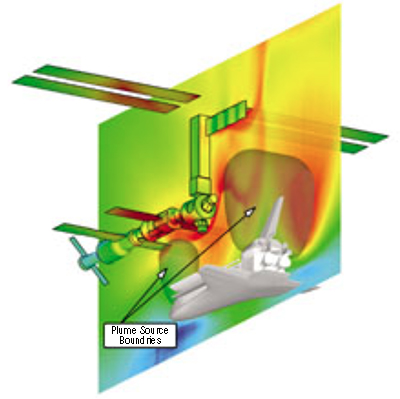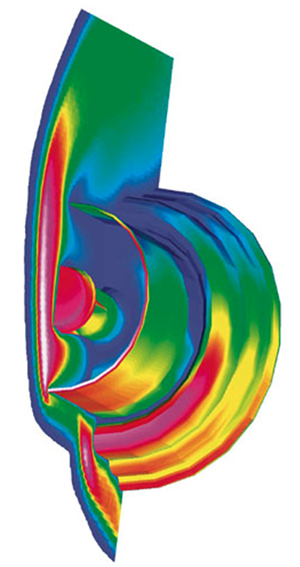Monte Carlo Methodology Serves Up a Software Success
Widely used for the modeling of gas flows through the computation of the motion and collisions of representative molecules, the Direct Simulation Monte Carlo method has become the "gold standard" for producing research and engineering predictions in the field of rarified gas dynamics. Direct Simulation Monte Carlo was first introduced in the early 1960s by Dr. Graeme Bird, a professor at the University of Sydney, Australia. It has since proved to be a valuable tool to the aerospace and defense industries in providing design and operational support data, as well as flight data analysis.
In 2002, NASA brought to the forefront a software product that maintains the same basic physics formulation of Dr. Bird's method, but provides effective modeling of complex, three-dimensional, "real" vehicle simulations and parallel processing capabilities to handle additional computational requirements, especially in areas where computational fluid dynamics (CFD) is not applicable. NASA's Direct Simulation Monte Carlo Analysis Code (DAC) software package is now considered the Agency's premier high-fidelity simulation tool for predicting vehicle aerodynamics and aerothermodynamic environments in rarified, or low-density, gas flows.
Additionally, DAC was recognized as the co-winner of the prestigious 2002 NASA Software of the Year award, for its time- and money-saving abilities. Because tests to acquire information on the interactions of spacecraft and rarified environments are difficult and expensive to perform, NASA believes DAC has the potential to save millions of dollars. NASA also acknowledges that DAC is easier to use and 100 times faster than the "standard process" software it replaced.
Developed by an engineering team in Johnson Space Flight Center's Aero-science and Flight Mechanics Division, DAC models the flow of low-density gases over flight surfaces. The accurate modeling of these flows, for which experimental facilities are virtually nonexistent, is critical for the protection of valuable NASA assets, and for ensuring crew safety and overall mission success. The software supports numerous Johnson programs, including the International Space Station (ISS), the X-38, and Space Shuttle servicing missions to the Hubble Space Telescope. DAC is also in use at other field centers, to monitor the Mars Pathfinder, Stardust, Genesis, X-33, X-37, Mars Global Surveyor, and Mars Odyssey vehicles.
More broadly, the DAC software serves as the benchmark for predicting flowfields generated on orbit by the Space Shuttle reaction control system thrusters, and the resultant impingement (effects of thruster firing when one spacecraft approaches another) on the ISS. Use of the DAC code in predicting flowfields has led to significant changes in docking procedures and venting operations. The technology is further used to provide information to help optimize and verify maneuvers of the Mars-orbiting spacecraft after they were slowed by repeatedly skimming through the planet's atmosphere ("aerobraking"), instead of depending upon thrusters for deceleration. This technique enabled the spacecraft to be lighter, which in return reduced launch costs.
The generality incorporated into DAC has allowed for widespread use of the software within the aerospace community beyond NASA. The National Missile Defense embraced the technology for interception of hostile missiles launched into the upper atmosphere, beyond the limits where traditional CFD methods would be functional. Department of Defense contractors such as Boeing and Raytheon employ the software to assess candidate kinetic warheads for ballistic missile defense systems. These contributions to missile defense are believed to bolster homeland security and provide citizens with an improved sense of safety.
DAC research is also prevalent at universities all across the country. The University of Colorado was first in utilizing DAC to analyze the rarified aerodynamics of a "wave rider" (a hypersonic vehicle that glides on its own shockwave) using the method of osculating cones. This method was developed at the University of Colorado in the late 1980s, and is now the standard for wave rider design. The motivation behind this research is the potential for using wave riders for aero-maneuvers in planetary atmospheres, particularly for aero-gravity assists. Such maneuvers were first proposed by Jet Propulsion Laboratory engineers approximately 15 years ago.
At the University of Maryland, DAC has been used to explore various problems of direct relevance to NASA and the U.S. Air Force. One instance involves the behavior of a satellite in a so-called "dipping orbit," which includes a low-altitude pass through the Earth's upper atmosphere. Several proposed future space missions will fly dipping orbits to perform experiments in the upper atmosphere, including Goddard Space Flight Center's Geospace Electrodynamic Connections mission.
Another project used DAC as a baseline to study the aerodynamic environment at the leading edge of a spacecraft as it reenters from orbit. University faculty and students are currently exploring options for minimizing, or even eliminating, the communications blackout period of a reentering vehicle. Field experts believe that, through careful selection of the spacecraft geometry, the amount of high-temperature plasma surrounding a reentering spacecraft can be dramatically reduced, permitting radio waves to travel more easily from the spacecraft to ground control, and back. Overall, University of Maryland researchers have found DAC to be extremely powerful, computationally efficient, and very easy to install and use.
The unique flow-solvers adapted to DAC make the software a good fit for other applications in which the object within the flowfield is extremely small, such as micro-electromechanical and nanotechnology devices. The software technology is also expected to make an impact in materials processing, including chemical vapor deposition and etching of thin films, and internal transport analysis of outgassing contaminants.

NASA’s Direct Simulation Monte Carlo Analysis Code serves as the benchmark for predicting flowfields generated on orbit by the Space Shuttle reaction control system thrusters, and the resultant impingement on the International Space Station.

The Raytheon Missile Systems Company used the software to develop Standard Missile-3 Infrared Seekers for the Missile Defense Agency. The seekers successfully intercepted a test target vehicle in January 2002, marking the first ship-launched ballistic missile intercept.













